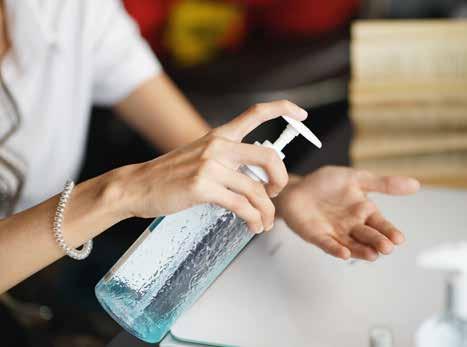
5 minute read
OH&S
COVID-19 – Your storage facility related OHS FAQs
By Stephen Pehm, OHS Consultant – Action OHS Consulting.
Many storage facilities have continued to operate with employees at work throughout the COVID-19 pandemic. New Zealand facilities are also now open. Most facilities by now have implemented changes reflecting a focus on continuous cleaning and disinfecting regimes, as well as social distancing measures.
In this article we answer some commonly asked questions that you may have in relation to working in a post COVID-19 world.
What can I do to support my employees?
Your workers may still be nervous about travelling to and from work on public transport (in spite of social distancing laws) and working in close proximity to colleagues. Are you doing the following to support them? l Ensure that a cleaning program is in place with at least daily sanitisation of commonly used areas. l Ensure that ample supplies of personal cleaning equipment are available to employees. Consult with them in determining these. l If working in shifts, try to minimise contact between each shift team. l Support spreading commuter loads on public transport by staggering start and end times for workers. l Provide signage, direction, and barriers to ensure that social distancing rules are maintained. l Consider providing sanitiser for visitors to use upon entering and exiting your workplace. Screen them to ensure that they are feeling well. l Mandate that all workers who do not feel well must remain at home and encourage them to get tested for
COVID-19. l Be prepared to close the workplace down and send all workers home in the event of a worker in the workplace developing COVID-19.
How can I get my workforce involved in our ‘new normal’?
It is important to involve your workers continuously when making decisions about how to return to work or any other changes you are making to manage COVID-19.
Involving your team in the design of control initiatives, inspecting workplace(s) to ensure that implemented controls are still in place, encouraging stakeholders to report issues including breaches of the rules, and taking action to resolve these are essential to manage this risk.
How can I continue to Support My Employees?
It is likely that many of us will continue to be nervous. Steps that could be taken to assure nervous employees may include: l Permitting employees in noncustomer facing roles to remain working from home and checking in frequently to determine a future return date. l Where possible empowering employees to determine their work start times to facilitate travel on less crowded public transport. Blended work days incorporating home and office based work may also be an option. l Ensuring that employees, no matter how senior, who breach
COVID-19 control rules are appropriately counselled not to do it again. This would include immediately sending home employees who present with cold/flu like symptoms. l Supporting what is being done to control COVID-19 with signage and visible direction. Visible examples of your commitment to managing the COVID-19 risk will be constantly reassuring to your employees. l Listen and taking action to address employee concerns and reviewing the effectiveness of what is done. l Employees who are distressed about returning to work may benefit from assistance from a mental health professional via an Employee
Assistance Scheme or similar
TACKLING CHALLENGES
As OHS professionals we have been excited (not in a weird way) by the challenges presented to us following the COVID-19 pandemic outbreak. For, arguably, the first time a specific workplace safety issue has been in the headlines for more than one day! We are also impressed with the way that self storage facilities have responded resulting in rapid and effective control of COVID so far. Workers and managers at all levels have consulted and worked together to demonstrably minimise the risk. We need this passion transferred into other safety areas!
Adopting the practice of identifying workplace hazards, assessing risk associated with them, implementing controls to manage the risk, and reviewing effectiveness of these controls, as was shown for COVID, works in making your workplace safer. And this works best if the owners lead from the front!
If one of my workers contracts COVID-19 at our workplace – or worse, there is an outbreak – what are the OHS legal ramifications?
An outbreak of COVID-19 in your workplace will have a dramatic effect on your business – a shutdown and deep clean would be an immediate consequence. From a legislative point of view, you may be liable for not providing a safe workplace for your employees if you do nothing to manage the risk of infection in your workplace. Reporting requirements if one of your workers develops COVID-19 symptoms in the workplace vary from jurisdiction to jurisdiction. Generally, if a worker in your workplace is hospitalised or dies from COVID-19 then you must report it to your Safety Regulator. If a COVID-19 case presents itself in your facility, you can contact the SSAA OHS Helpdesk on 1800 067 313 for advice.

What about industrial manslaughter law – does this apply to COVID?
Industrial manslaughter laws (relating to Employers and associated Company Officers) may be in place in your State and may apply to COVID-19 related harm. If you are a Company Officer, the best way to avoid an Industrial Manslaughter (and a workplace safety related) prosecution is to ensure that COVID-19 is being controlled in your workplace in a systematic way (see above). An employee testing positive may also precipitate a worker’s compensation claim, which could affect your premium and cost you money. all parties are clear on when work from home will be taking place.
Revisit this agreement on an annual basis. All work-from-home employees should redo the checklist before resigning the agreement. Having these basic steps in place will provide comfort that work from home is being managed adequately.
What should I be thinking about to plan ahead?
Looking past the COVID-19 challenge (we will overcome this) if your workers are working from home on a permanent basis the following safety related issues may require ongoing management
Psychosocial hazards, measuring productivity and working together effectively may be more challenging areas to manage if key team members are working remotely. l
What are my responsibilities to my team who continue to work from home?
It is a good idea to get all workers working from home to complete a ‘working from home checklist’ specifying that they have a safe workstation setup place and also to sign a documented ‘working from home agreement’ so that
The OH&S Help Desk has been established by the SSAA to support its members. This advisory service is free. Free call 1800 067 313 (Australia); 0800 444 356 (New Zealand); or email admin@selfstorage.com.au.

